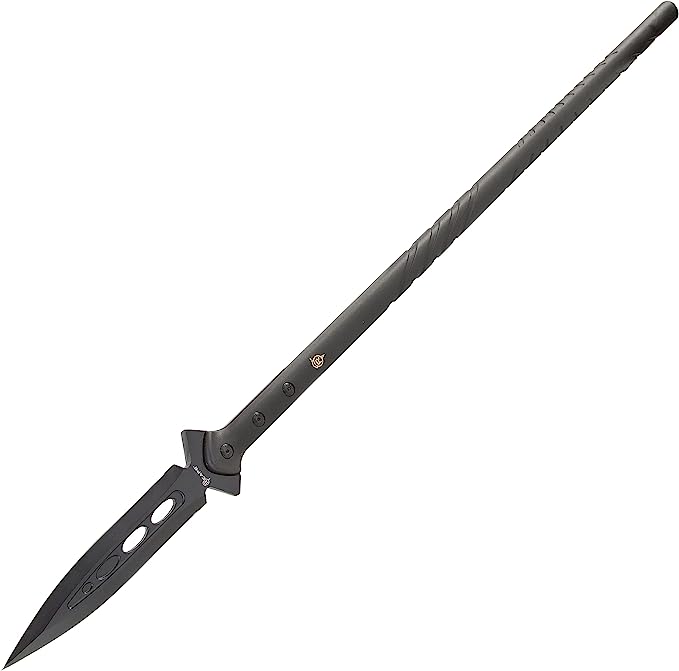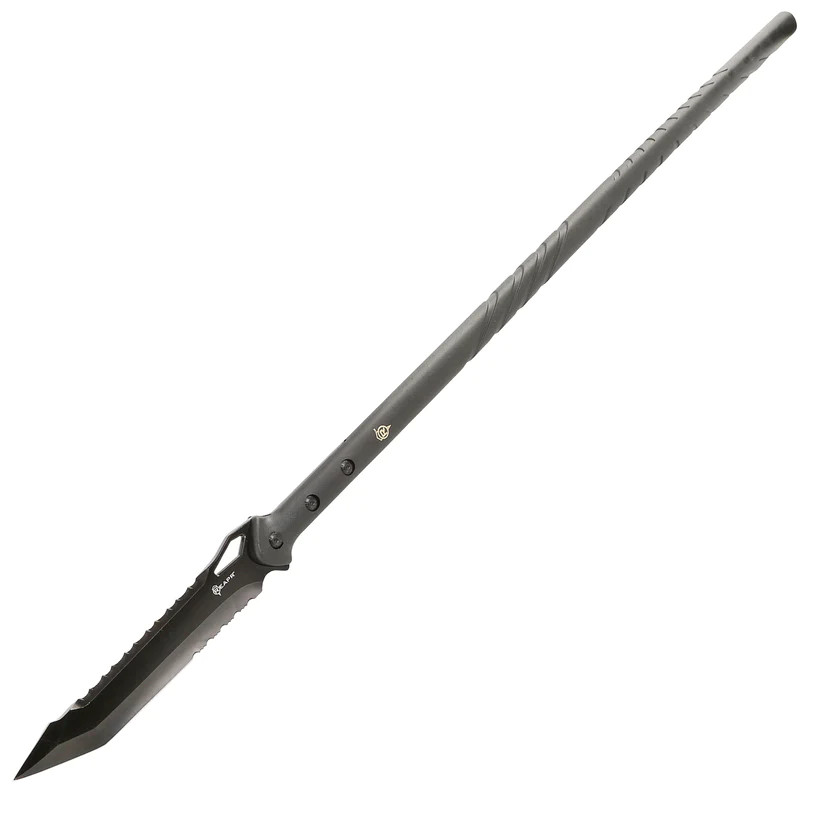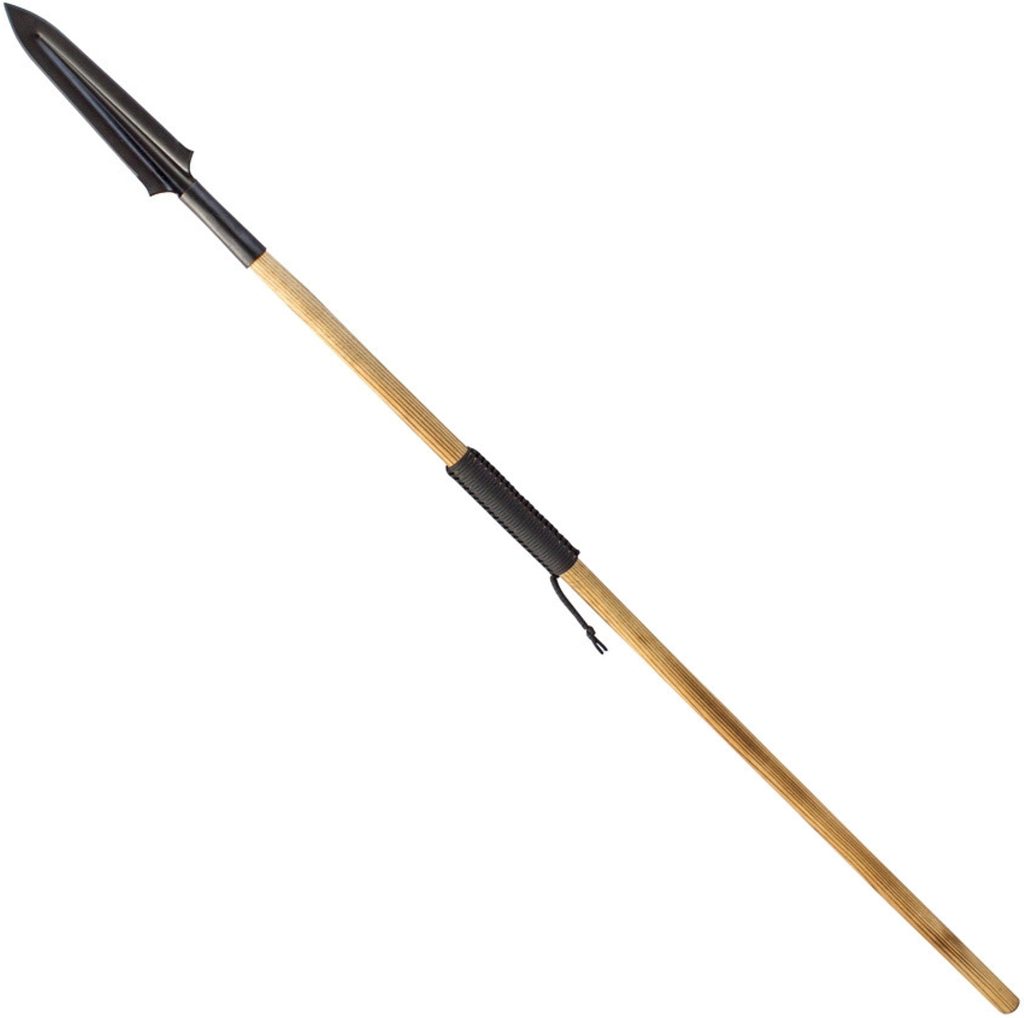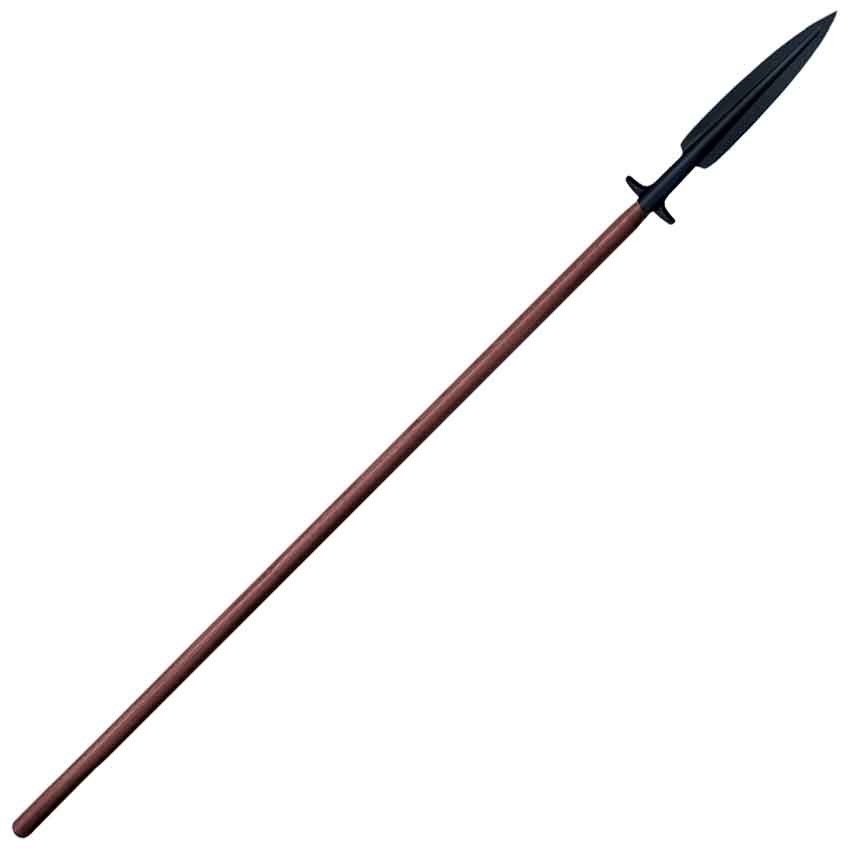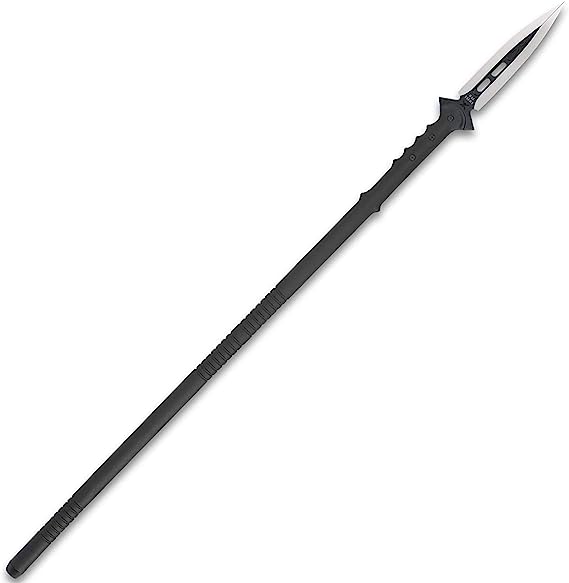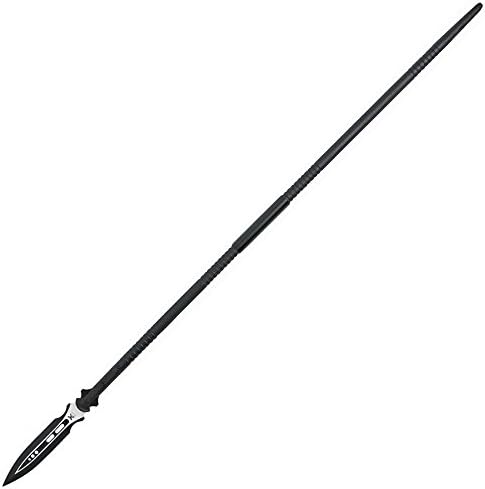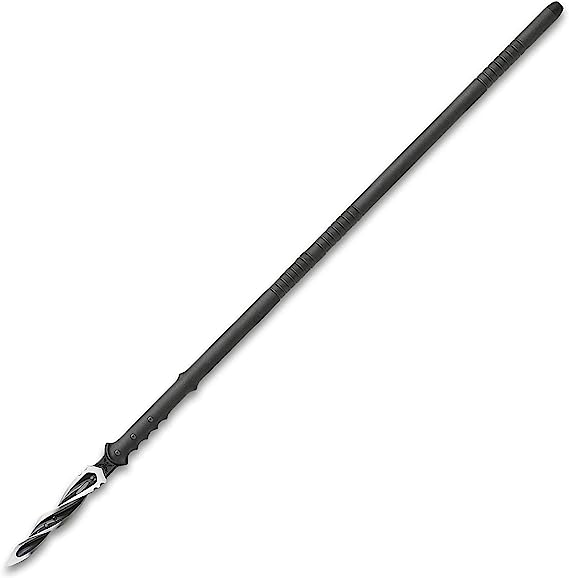Hunting savage wild hogs with a boar spear is a dangerous sport and has a history almost as old as mankind itself. Homer, the Greek historian, wrote about boar hunting centuries before Christ was born. The Greek god, Hercules, was said to be a boar hunter, and the legendary King Arthur of early English mythology was reported to have hunted wild pigs. In India, lancers practiced their skills by taking wild hogs with spears from a horse. Ancient tombs contained drawings depicting hog hunting with spears.
The men who hunted the savage boar had great respect for the animal’s ability to cut and maim. An old hunting guide in India once claimed that a wild boar was tough enough to drink water between tigers, and there are actual accounts of tigers being fought and killed by boars. Hog hunting was so popular in the 19th century that one sportsman wrote, “If fox hunting is the sport of kings, then pig sticking is surely the sport of everyone else.”
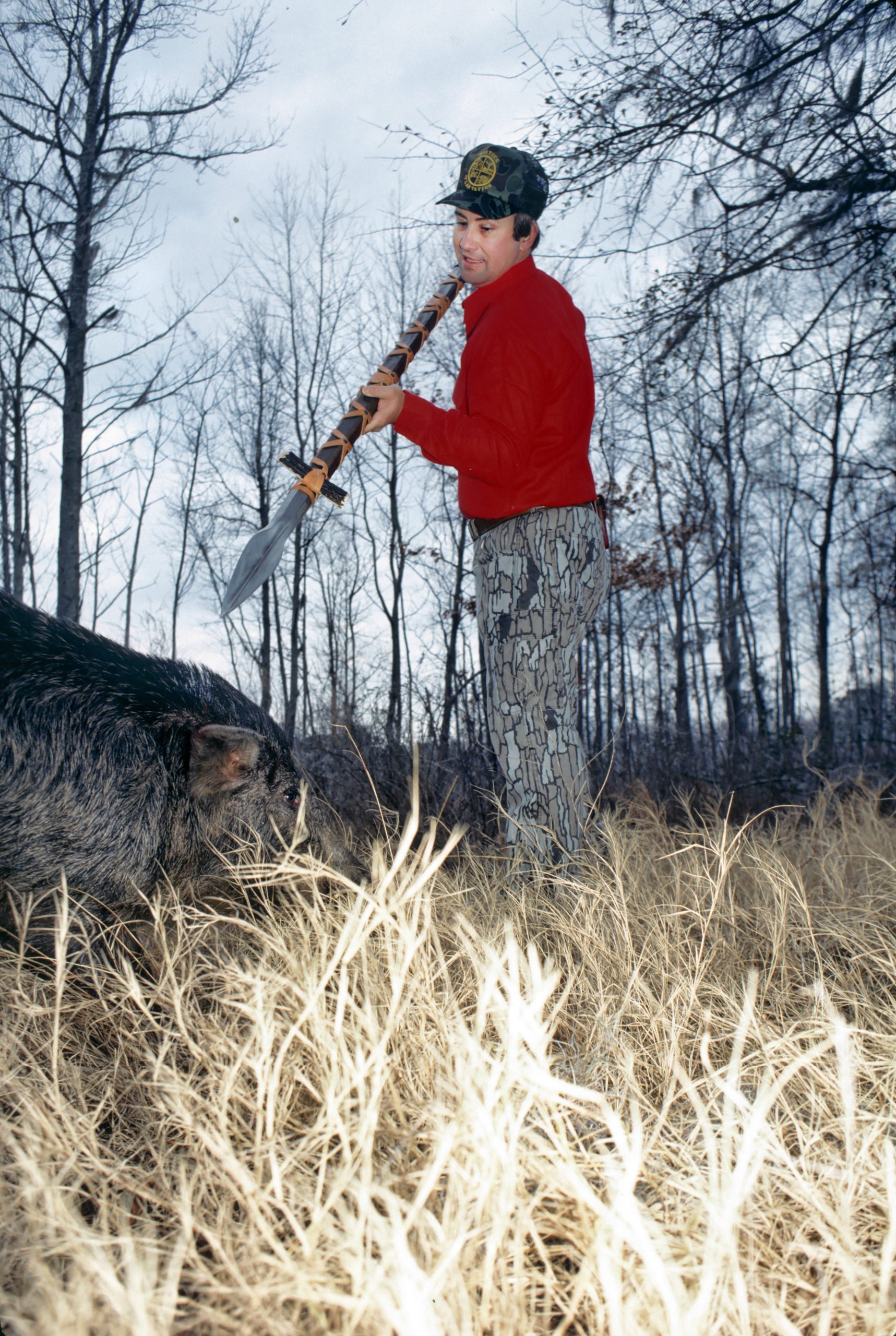
So, hunting hogs with a spear wasn’t a new idea when I decided to undertake my hunt. However, I didn’t uncover two important facts about the sport until my hunt for a wild boar with a spear had ended. The first pig hunters usually hunted in teams, so one man could distract the hog, while the others speared the pig from different angles. Once the horse was domesticated, most hunters left the ground for the safety of the horse’s back.
Wild Boar History In The U.S.
Many tales exist as to when wild hogs were introduced into America. History does reveal that some of the first stock was domestic swine released around farms by colonists to fend for themselves. In the spring, the hogs were tolled up, captured in traps where they were marked to show ownership and then either released or taken to market.
The first European boars brought into this country were introduced into a game park in Sullivan County, New Hampshire, by Austin Corbin in the early 1890s from Germany’s Black Forest. Another introduction of wild European boar was made in the Great Smoky Mountains of North Carolina after World War II. In the early part of the 20th century, an Englishman named George Moore leased a large portion of land near Hooper Bald, a few miles past the Tennessee and North Carolina state line in North Carolina, to set-up a game sanctuary. In 1910, he brought in crates filled with wild boars and released them, with some eventually escaping into the Great Smoky Mountains where they interbred with feral and domestic hogs.
Why You Should Try Boar Hunting With A Spear
“You’re going to do what with a what?” a friend of mine asked when I tried to explain that I wanted to take a wild boar with a spear like European nobility once did. “Well, John, if you want to hunt hogs the old way, I think you should hunt hogs with a tradition behind them, hogs with ancestors that have been in this country ever since Europeans came here and have a lineage that can be traced back to before the days of the American Revolution. You should hunt the Savannah River swamp hogs on the Bostick Plantation near Estill, South Carolina. The forebearers of these hogs were released by the members of the Bostick family when they came to this country with a land grant from the King of England.”
When I contacted the then manager at the Bostick Plantation, he also asked, “You want to do what? John, do you realize the hogs we hunt have long, sharp tusks that can kill a dog and cripple a man? Hunting hogs with a spear is dangerous business.”
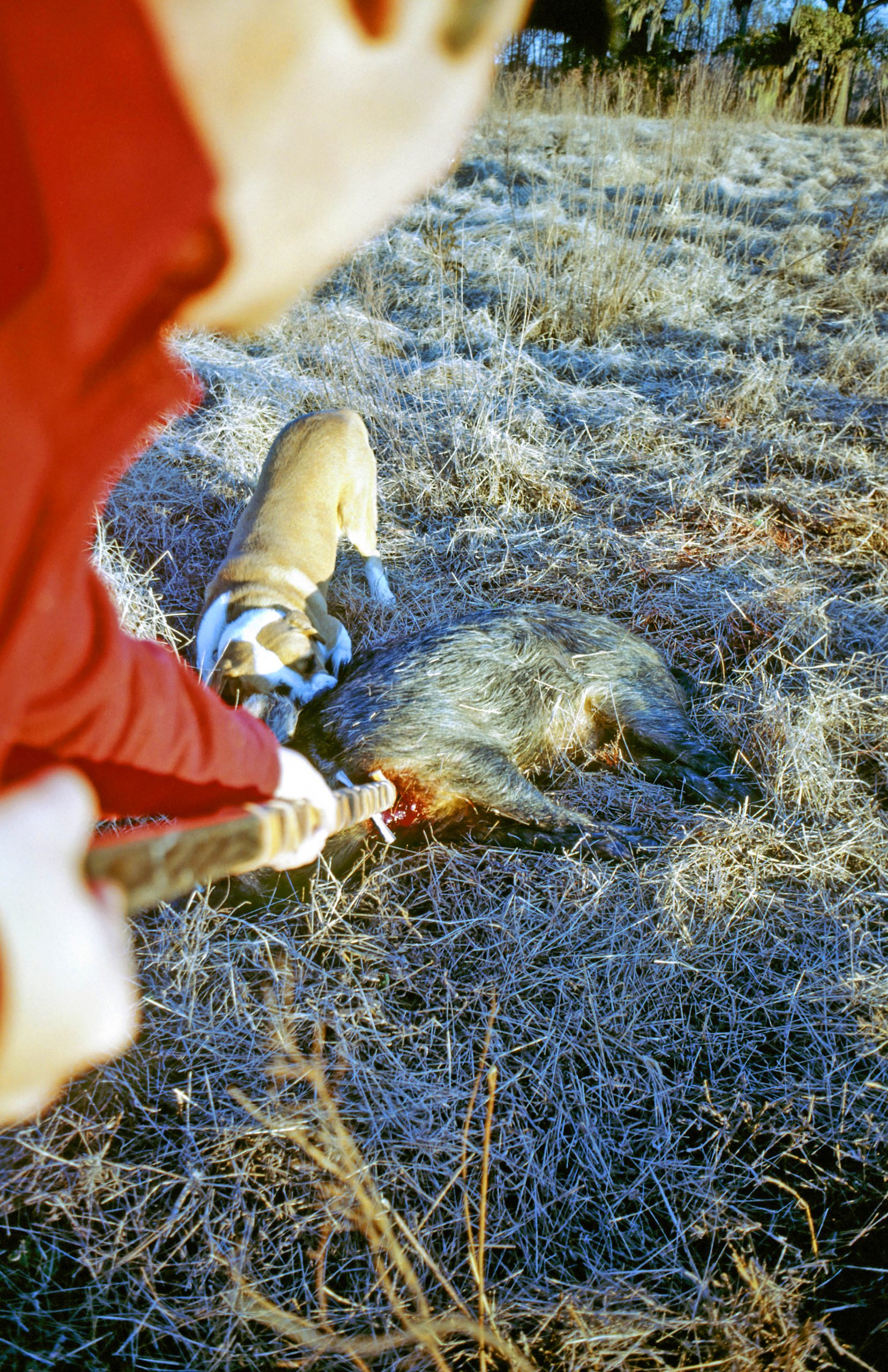
I admitted I was somewhat apprehensive but explained, “I’m not trying to prove anything. But I’d like to gain a greater insight into this very-old method of hunting.”
Part of my interest in boar hunting had come from a Christmas present my wife had given me of my Phillips’ family coat of arms that featured on its top a black boar head with big tusks on it, and the words, “Spero meliora,” which translated meant, “I aspire to greater things.” It also had numerous small boars’ heads in its center.
For the hunt, I chose the famous Puma spear made in Germany, that’s still available today, that featured a heavy, forged, carbon-steel point and a solid-wood handle wrapped with leather and studded to prevent my hands from slipping. The trip was set-up.
The Boar Spear Hunting Process
We hunted hard the first day of my wild boar hunt in South Carolina but couldn’t find the size of hog I wanted to take. My guide had a quality pack of dogs, including bay dogs and catch dogs. I quickly realized that hunting for wild hogs in a swamp wasn’t for the faint-hearted. Within the first 30 minutes, we had waded one thigh-high creek, crawled through three briar patches and been beaten by one very-thick cane thicket. Because of the cover’s thickness, I realized that wielding the spear might be difficult. However, I had faith in my guide and his experienced and courageous hounds.
Since there’s no closed season on feral pigs in South Carolina, sportsmen hunt wild hogs with hounds year-round. The traditional method of taking a hog is to chase it. When the dogs bay the pig, the guide usually moves quickly and deliberately behind the hog and grabs it by its hind legs, throwing it to the ground. The hunter then goes in with a knife with at least a five inch blade and made of heavy enough metal to put a hog down. He grabs the pig’s front legs, rolls the animal over and blades the tusker between its forelegs. Another technique sometimes utilized is to come in behind the guide and take the boar with a handgun.
The next day we’d been hunting for about three hours when we heard the bay dogs bark as they ran through the bushes and brambles. The foot race toward danger was on, as we heard the squealing and grunting of a wild pig. When we arrived at the scene, the catch dog, a 60-pound bulldog, was turned loose. The dog went in quickly and deliberately, grabbed the 150-pound pig’s ear and held on, while my guide circled the animal, grabbed the hog’s hind legs and threw it to the ground. We then realized that the hog wasn’t trophy quality either.
The hunt continued, and shortly we cornered a second hog – a trophy boar of about 250 pounds with sharp tusks and a huge head. My guide said, “Take the hog now if you want to while I hold him.”
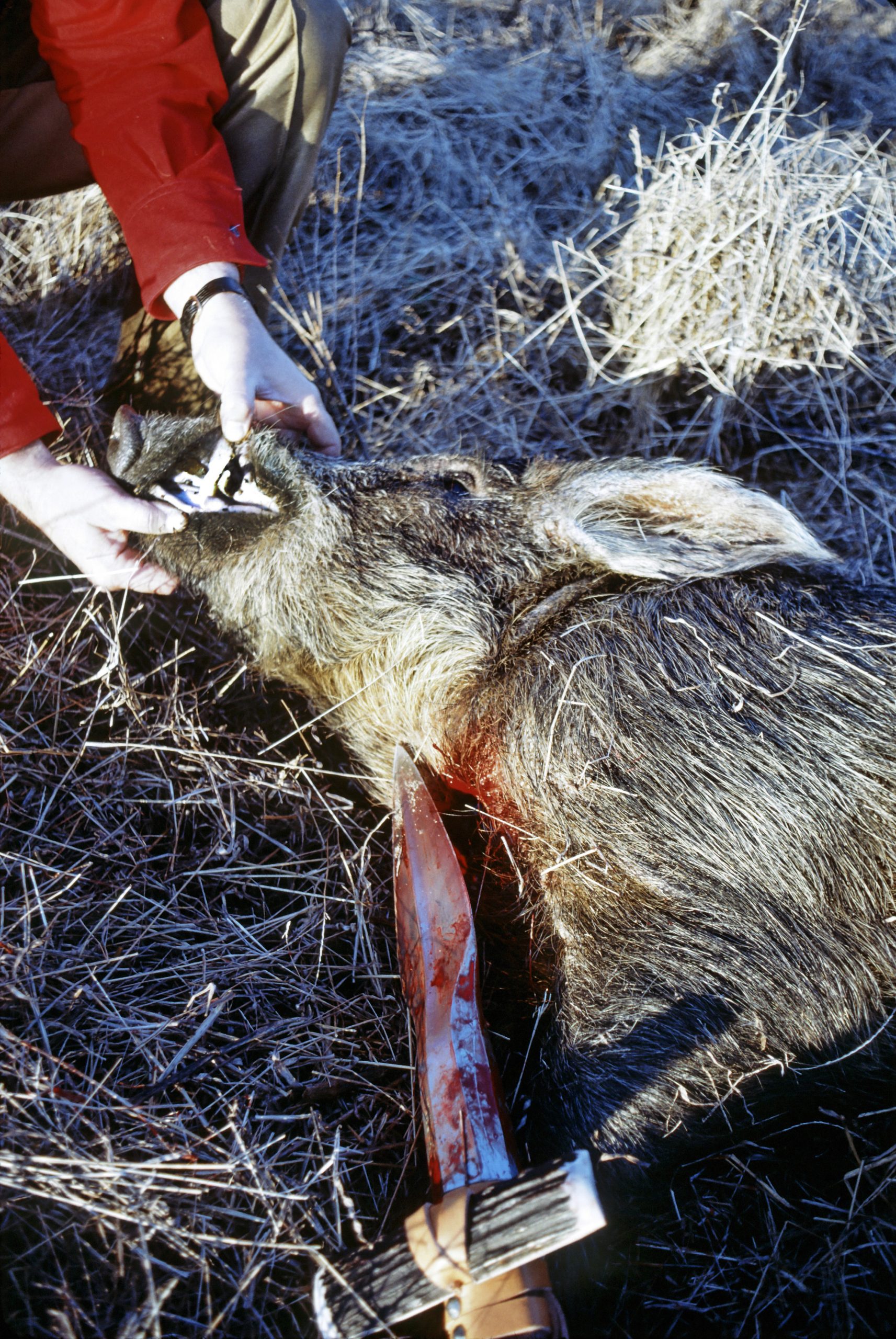
I lunged with all the power I could muster to drive the blade of the spear between the boar’s two front shoulders, much like a matador would take a bull with his sword. Although I thought the gap between the boar’s formidable shoulder shields would be larger, I quickly learned that the gap was no more than 1/2- to 1/4-inch wide. Even if the boar was hit, the shield would pinch together to prevent the spear from penetrating. I’d spent hours with a grinding stone and a whetstone to be certain the spear was sharp, but when I tried to drive it home, it hit the hog’s armored plates and penetrated no more than 1/8-inch.
My guide then said, “You’d have been in a world of hurt if I’d let that hog go. I’ve seen hogs keep on running after being hit on the shoulder or between the shoulders with #00 buckshot. The only place you’ll probably be able to take the hog is to hit him under his throat when the hog throws his head up to escape.”
Following his instructions, I lunged again, this time for the boar’s throat. The Puma spear did the job it was designed to do. The tusker fell.
How To Choose A Boar Spear
When choosing a boar spear, consider the following factors to ensure you select the most suitable one for your needs:
- Spearhead Design: Look for a spearhead specifically designed for boar hunting. It should have a sturdy and sharp point with a reliable piercing capability. Some spearheads may feature barbs or serrations to improve retention and prevent the boar from escaping.
- Material and Durability: Opt for a spearhead made of high-quality and durable materials such as stainless steel or carbon steel. These materials offer excellent strength and resistance to corrosion. Ensure the spearhead is capable of withstanding the force of impact during hunting.
- Shaft Length and Material: The length of the shaft depends on personal preference and hunting conditions. Longer shafts provide increased reach, while shorter ones offer better maneuverability in dense vegetation. Choose a shaft made of robust wood or a sturdy synthetic material that can handle the stress of hunting.
- Handle Grip: Look for a boar spear with a comfortable and secure grip. Consider features such as grooves, texture, or rubberized coatings that enhance your hold on the spear, even in wet or slippery conditions.
- Weight and Balance: A well-balanced spear is crucial for accurate throws and effective penetration. Test the weight distribution of the spear to ensure it feels comfortable and balanced in your hands.
- Versatility: If you intend to use the spear for purposes other than boar hunting, consider its versatility. Some boar spears may have additional features such as detachable heads or the ability to convert into other tools like a hunting knife or a fishing spear.
- Brand and Reviews: Research reputable brands known for producing reliable hunting equipment. Read customer reviews and seek recommendations to gauge the performance and durability of the boar spear.
- Legal Considerations: Ensure the boar spear adheres to local hunting regulations and restrictions. Check if there are any specific guidelines regarding spear length, spearhead design, or permitted hunting methods for boars in your area.
By considering these factors, you can choose a boar spear that meets your hunting requirements, offers durability, and enhances your overall hunting experience.
Best Boar Spears
Reapr Survival Spear
Features
- 2Cr13 stainless-steel precision cast head
- Hunting spear with 8-1/8 in. double edge blade for durability
- Nylon-fiberglass reinforced handle for comfortable grip
- Rubberized TPR snap sheath for long-lasting use
- Measures 44 in. overall length; hand measures 36 in. length
- GreatNeck limited lifetime warranty
Tailored for boar hunting purposes, this spear excels in piercing, prying, impaling, and breaching tasks while also serving as a reliable tool for general protection. With a shorter shaft compared to many others, this spear proves exceptionally advantageous for close-quarters survival and hunting situations. Its weighted stainless-steel double-edged blade provides substantial power and force, while the grooved grip enhances accuracy and comfort during throwing actions.
Reapr TAC Javelin Serrated Spear
Features
- 8 in. partially-serrated clip point blade with black oxide-coated finish
- Stainless-steel precision cast head for durability
- Serrated spear with nylon and fiberglass reinforced handle
- Grooved grip adds comfort and optimizes aim
- Overall length measures 44 in.; handle measures 36 in.
- Lightweight and durable thermoplastic rubber snap sheath
- GreatNeck limited lifetime warranty
The Reapr TAC Javelin Serrated Spear is tailored specifically for boar hunting. Engineered for exceptional piercing, prying, impaling, and sticking capabilities, this robust serrated spear stands as the ultimate choice for tactical boar hunting. Additionally, its remarkable features include a 2Cr13 stainless-steel precision cast head, along with an 8-inch partially serrated clip point blade adorned with a sleek black oxide finish.
Condor Tool & Knife Yari Spear
Features
- Blade length: 14-1/2in
- Overall length: 64-1/2in
- Blade thickness: 0.10in
- Constructed of 1075 high carbon steel, heat treated and annealed to 50-55 Rockwell C scale
- Heavy black powder epoxy coating
- Handle is made of burnt American ash
- The sheath included is high quality, heavy duty, and hand crafted leather
The Condor Tool & Knife Yari Spear is a formidable weapon designed specifically for boar hunting. With its expert craftsmanship and sturdy build, this spear offers exceptional durability and reliability in the face of challenging hunting situations. The Yari Spear features a razor-sharp, high-carbon steel blade that excels at piercing and impaling boars with precision. Its ergonomic handle provides a secure grip, ensuring accurate and controlled handling during intense hunting encounters.
Cold Steel Boar Spear
Features
- Forged out of medium carbon SK-5 steel
- Heat treated to a spring temper
- Flexes under stress rather than breaking
- Comes complete with heavyweight American Ash shaft and a sturdy Secure-Ex Sheath
- Blade Length: 18-1/2″ (Head)
- Handle: 71″ x 1-2″ Premium Ash
- Overall Length: 82-1/8″
- Steel: SK-5 Medium Carbon
- Weight: 68 ounces overall
The Cold Steel Boar Spear is the ultimate weapon for boar hunting. Crafted with precision and expertise, this spear is specifically designed to take down even the toughest boars. Its razor-sharp, stainless-steel blade is engineered for maximum penetration and impaling power, ensuring a swift and effective takedown. The durable and ergonomic handle offers a secure grip, allowing for precise control during intense hunting situations. Trust in the Cold Steel Boar Spear to deliver exceptional performance and make your boar hunting adventures a resounding success.
M48 Talon Survival Spear
Features
- 8″ blade length
- 44-1/8″ overall length
- 2Cr13 Stainless steel
- 30-Percent Fiberglass reinforced nylon handle
- Includes TPR snap sheath
Prepare yourself for boar hunting with the remarkable M48 Survival Spear by United Cutlery. This impressive spear measures an astounding 44 1/8″ in length, featuring an 8″ blade that is exceptionally sharp and nearly half an inch thick. Constructed with stainless steel, this spear is built to withstand rigorous use and offers remarkable durability. Its versatility shines through various practical applications, including breaching, prying, and impaling. The meticulously crafted handle, designed as a cane with 30% fiberglass composition, ensures near-indestructibility. Additionally, a durable TPU sheath is included to protect and carry the spear.
M48 Magnum Spear
Features
- 10 3/4″ cast stainless steel blade
- Black oxide coating and satin finish
- Aluminum shaft with glass-fiber-filled nylon handle
- Vortec sheath included
- Breaks down for transport and storage
- Overall length: 65 1/2″
Boasting an impressive overall length of 65 1/2″, this tactical spear stands unrivaled as the longest of its kind. Equipped with a 10 3/4″ cast stainless steel blade, featuring a formidable black oxide coating and satin finish, it commands undeniable power. The spear is skillfully attached to a handle made of glass-fiber-reinforced nylon, reinforced with an aluminum shaft. Molded grooves on the handle ensure an incredibly secure grip. For convenience, this remarkable spear easily breaks down into two pieces, facilitating effortless transport and storage. When assembled, a steel sleeve ensures a rock-solid handle. Accompanied by a Vortec sheath, this extraordinary spear is ready to conquer any boar hunting expedition you embark upon.
M48 Cyclone Spear
Features
- 9” cast stainless steel blade with three spiraling cutting edges
- 48 7/8″ overall length
- glass-fiber-reinforced nylon handle
- Custom Vortec belt sheath
Introducing the M48 Cyclone Spear, a colossal weapon measuring an impressive 48 7/8″ from end to end, featuring the iconic three spiraling cutting edges that converge into an incredibly sharp piercing point, which made the Cyclone highly coveted. This mighty spear is equipped with a 9″ cast stainless steel blade that exudes immense power, while its glass-fiber reinforced nylon handle ensures remarkable toughness. Constructed for durability and robust use, the M48 Cyclone Spear presents countless practical applications, including breaching, prying, and impaling virtually anything. Unleash the might of this massive spear during your boar hunting endeavors and experience unrivaled performance.
FAQs
Why do boar hunting spears have wings?
Boar hunting spears often have wings for several reasons. The wings, also known as barbs or flanges, serve specific purposes that aid in successful hunting. Here are some reasons why boar hunting spears have wings:
- Improved Stopping Power: The wings on a boar hunting spear increase its surface area, making it more difficult for the spear to be dislodged from the boar’s body. The additional resistance provided by the wings helps in immobilizing the boar and preventing it from escaping.
- Enhanced Penetration: The wings on the spear create drag and increase stability during the throw, improving accuracy and penetration. The design allows the spear to penetrate deeply into the boar’s flesh, ensuring a more effective and humane kill.
- Increased Wound Channel: The wings create larger entry wounds upon impact, resulting in a wider wound channel. This can lead to more significant tissue damage and increased bleeding, increasing the chances of a swift and ethical kill.
- Preventing Spear Slippage: When a boar is struck by a hunting spear with wings, the barbs help prevent the spear from slipping out of the boar’s body. This feature is crucial in boar hunting, as boars are strong and resilient animals that can continue to fight even after being speared.
- Retrieval and Tracking: The wings on a boar hunting spear make it easier to track and locate the animal. They can snag on branches or vegetation as the boar moves through the environment, leaving a visible trail for the hunter to follow.
It’s important to note that regulations and hunting practices can vary in different regions, so it’s essential to adhere to local laws and guidelines when using hunting spears or any other hunting equipment.
How long are boar spears?
The length of boar spears can vary depending on personal preference and hunting style. However, boar spears typically range from around 4 to 6 feet (1.2 to 1.8 meters) in length. This length allows hunters to maintain a safe distance while effectively thrusting the spear towards the boar.
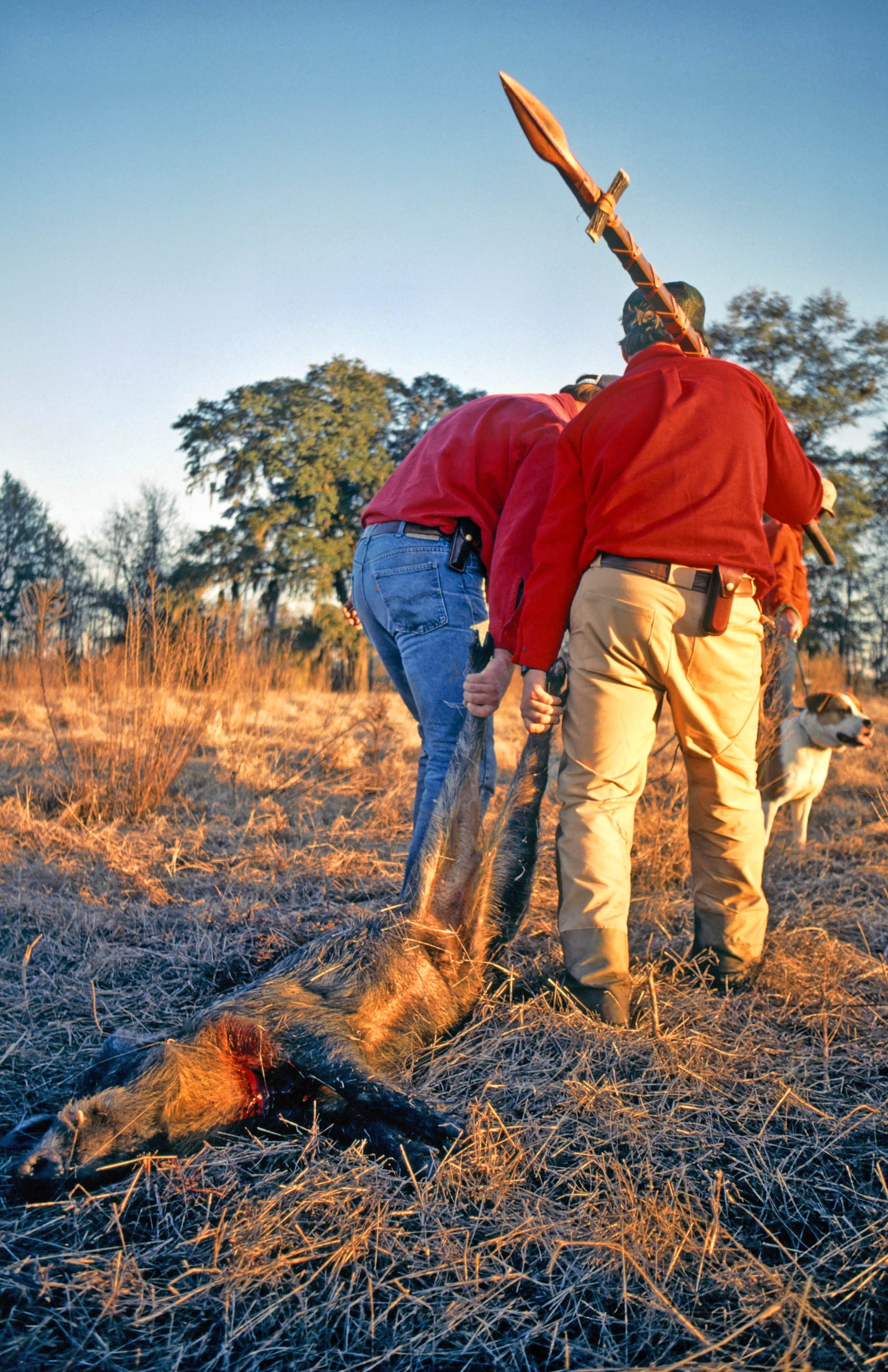
Some hunters may prefer shorter spears for better maneuverability and ease of handling in dense vegetation or close-quarters encounters. On the other hand, longer spears provide increased reach and leverage, which can be advantageous when facing larger or more aggressive boars.
How heavy are boar spears?
The weight of a boar spear typically ranges from 1 to 4 pounds (0.45 to 1.8 kilograms). Lighter spears are more maneuverable and easier to handle, allowing for quick and precise movements during the hunt. Heavier spears, on the other hand, provide more impact and penetration power, which can be advantageous when dealing with larger boars or for hunters who prefer a heavier feel.
How to make a boar spear?
Making a boar spear requires careful planning and proper tools. Here’s a general guide to help you create your own boar spear:
Materials and Tools Needed:
- Spearhead: You can purchase a pre-made spearhead or create one by shaping a sturdy piece of steel or iron.
- Shaft: Choose a strong and durable wooden pole, typically around 5 to 6 feet long, such as ash, oak, or hickory.
- Fasteners: You’ll need screws, bolts, or rivets to securely attach the spearhead to the shaft.
- Basic hand tools: These include a saw, drill, chisel, file, and sandpaper.
- Safety equipment: Wear protective gloves and eye goggles when handling sharp tools.
Step-by-Step Process:
- Prepare the spearhead: Shape or refine the spearhead as desired, ensuring it has a pointed end and sturdy construction. Sharpen the edges appropriately.
- Prepare the shaft: Cut the wooden pole to the desired length using a saw. Smooth any rough edges with sandpaper.
- Create a socket: Carve or chisel a socket at the base of the shaft to accommodate the spearhead. The socket should be deep enough to securely hold the spearhead.
- Attach the spearhead: Align the spearhead with the socket and mark the location for attachment. Drill holes through both the socket and spearhead, ensuring they match up. Use screws, bolts, or rivets to fasten them together tightly.
- Finishing touches: File down any sharp edges or rough spots on the spearhead. Sand the entire shaft to ensure a smooth and comfortable grip.
- Test and adjust: Once the spear is assembled, test its stability and balance. Make any necessary adjustments to ensure proper handling.
Remember, when using a boar spear or any hunting equipment, always prioritize safety and adhere to local hunting regulations.
Final Thoughts On Boar Spears
Hog hunting with a spear is a dangerous sport that shouldn’t be taken lightly. If you face a hog in open terrain with a spear, your odds of surviving the encounter and actually bagging the boar without injury may be slim. However, if you do plan to try and down a tusker, use a spear that you’ve spent hours sharpening, and one that has enough mass to it like mine to stop the wild boar’s charge.
Always listen to an experienced boar-hunting guide. If he says the situation is too dangerous, follow his recommendations. Do more research into the sport of hog hunting with a spear. Thousands of men have faced the slashing tusks of wild pigs throughout the centuries. Remember, a wild boar can hurt you, and no trophy is worth a hospital stay.
Full Disclosure: This post may include affiliate links. There’s no extra charge to our readers for using these.


